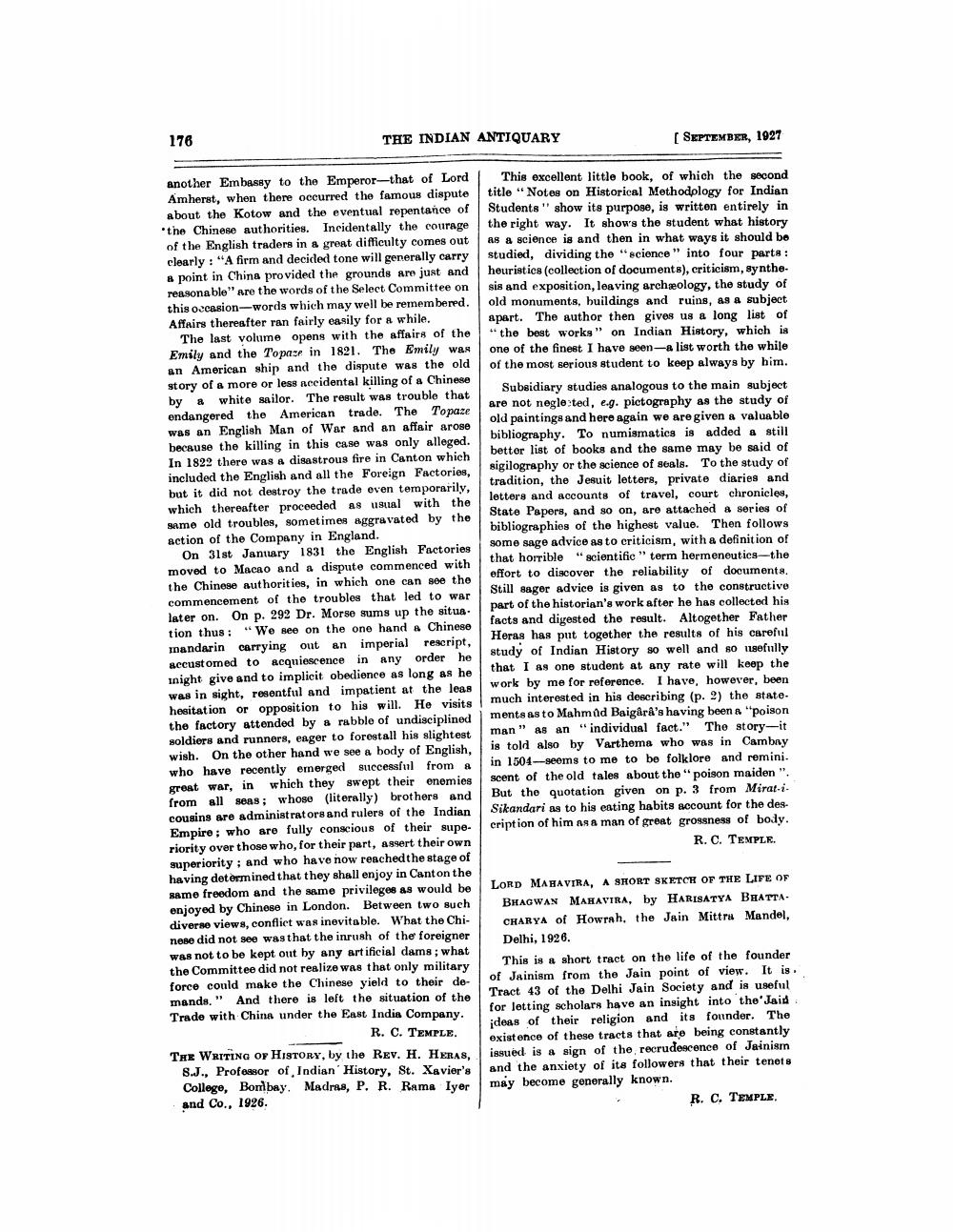________________
176
THE INDIAN ANTIQUARY
another Embassy to the Emperor-that of Lord Amherst, when there occurred the famous dispute about the Kotow and the eventual repentance of the Chinese authorities. Incidentally the courage of the English traders in a great difficulty comes out clearly: "A firm and decided tone will generally carry a point in China provided the grounds are just and reasonable" are the words of the Select Committee on this occasion-words which may well be remembered. Affairs thereafter ran fairly easily for a while..
The last volume opens with the affairs of the Emily and the Topaze in 1821. The Emily was an American ship and the dispute was the old story of a more or less accidental killing of a Chinese by a white sailor. The result was trouble that endangered the American trade. The Topaze was an English Man of War and an affair arose because the killing in this case was only alleged. In 1822 there was a disastrous fire in Canton which
included the English and all the Foreign Factories, but it did not destroy the trade even temporarily, which thereafter proceeded as usual with the same old troubles, sometimes aggravated by the action of the Company in England.
On 31st January 1831 the English Factories moved to Macao and a dispute commenced with. the Chinese authorities, in which one can see the commencement of the troubles that led to war later on. On p. 292 Dr. Morse sums up the situa tion thus: "We see on the one hand a Chinese mandarin carrying out an imperial rescript, accustomed to acquiescence in any order he inight give and to implicit obedience as long as he was in sight, resentful and impatient at the leas hesitation or opposition to his will. He visits the factory attended by a rabble of undisciplined soldiers and runners, eager to forestall his slightest wish. On the other hand we see a body of English, who have recently emerged successful from a great war, in which they swept their enemies from all seas; whose (literally) brothers and cousins are administrators and rulers of the Indian Empire; who are fully conscious of their superiority over those who, for their part, assert their own superiority; and who have now reached the stage of having determined that they shall enjoy in Canton the same freedom and the same privileges as would be enjoyed by Chinese in London. Between two such diverse views, conflict was inevitable. What the Chinese did not see was that the inrush of the foreigner was not to be kept out by any artificial dams; what the Committee did not realize was that only military force could make the Chinese yield to their demands." And there is left the situation of the Trade with China under the East India Company. R. C. TEMPLE. THE WRITING OF HISTORY, by the REV. H. HERAS, S.J., Professor of Indian History, St. Xavier's College, Bombay. Madras, P. R. Rama Iyer and Co., 1926.
[ SEPTEMBER, 1927
This excellent little book, of which the second title "Notes on Historical Methodology for Indian Students" show its purpose, is written entirely in the right way. It shows the student what history as a science is and then in what ways it should be studied, dividing the "science" into four parts: heuristics (collection of documents), criticism, synthe sis and exposition, leaving archaeology, the study of old monuments, buildings and ruins, as a subject apart. The author then gives us a long list of "the best works" on Indian History, which is one of the finest I have seen-a list worth the while of the most serious student to keep always by him.
Subsidiary studies analogous to the main subject are not neglected, e.g. pictography as the study of old paintings and here again we are given a valuable bibliography. To numismatics is added a still better list of books and the same may be said of sigilography or the science of seals. To the study of tradition, the Jesuit letters, private diaries and letters and accounts of travel, court chronicles, State Papers, and so on, are attached a series of bibliographies of the highest value. Then follows some sage advice as to criticism, with a definition of that horrible "scientific" term hermeneutics-the effort to discover the reliability of documents. Still sager advice is given as to the constructive part of the historian's work after he has collected his facts and digested the result. Altogether Father Heras has put together the results of his careful. study of Indian History so well and so usefully that I as one student at any rate will keep the work by me for reference. I have, however, been. much interested in his describing (p. 2) the state. ments as to Mahmûd Baigârâ's having been a "poison man" as an "individual fact." The story-it is told also by Varthema who was in Cambay in 1504-seems to me to be folklore and remini. scent of the old tales about the "poison maiden ". But the quotation given on p. 3 from Mirat-iSikandari as to his eating habits account for the des cription of him as a man of great grossness of body. R. C. TEMPLE.
LORD MAHAVIRA, A SHORT SKETCH OF THE LIFE OF BHAGWAN MAHAVIRA, by HARISATYA BHATTACHARYA of Howrah, the Jain Mittra Mandel, Delhi, 1926.
This is a short tract on the life of the founder of Jainism from the Jain point of view. It is. Tract 43 of the Delhi Jain Society and is useful for letting scholars have an insight into the Jaid ideas of their religion and its founder. The existence of these tracts that are being constantly issued is a sign of the recrudescence of Jainism and the anxiety of its followers that their tenets may become generally known.
R. C. TEMPLE.




